How do you prevent a critical care nurse from accidentally delivering a morphine overdose to an ill patient? Or ensure that people don't insert their arm into a hydraulic mulcher? And what about enabling trapped airline passengers to escape safely in an emergency? Product designers and engineers face myriad such questions every day. Failure to answer them correctly can result in product designs that lead to injury or even death due to use error. Historically, designers and engineers have searched for answers by sifting through complicated safety standards or obscure industry guidance documents. Designing for Safe Use is the first comprehensive source of safety-focused design principles for product developers working in any industry. Inside you’ll find 100 principles that help ensure safe interactions with products as varied as baby strollers, stepladders, chainsaws, automobiles, apps, medication packaging, and even airliners. You’ll discover how protective features such as blade guards, roll bars, confirmation screens, antimicrobial coatings, and functional groupings can protect against a wide range of dangerous hazards, including sharp edges that can lacerate, top-heavy items that can roll over and crush, fumes that can poison, and small parts that can pose a choking hazard. Special book features include: Concise, illustrated descriptions of design principles Sample product designs that illustrate the book’s guidelines and exemplify best practices Literature references for readers interested in learning more about specific hazards and protective measures Statistics on the number of injuries that have arisen in the past due to causes that might be eliminated by applying the principles in the book Despite its serious subject matter, the book’s friendly tone, surprising anecdotes, bold visuals, and occasional attempts at dry humor will keep you interested in the art and science of making products safer. Whether you read the book cover-to-cover or jump around, the book’s relatable and practical approach will help you learn a lot about making products safe. Designing for Safe Use is a primer that will spark in readers a strong appreciation for the need to design safety into products. This reference is for designers, engineers, and students who seek a broad knowledge of safe design solutions. .












